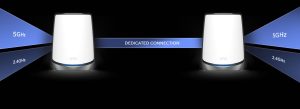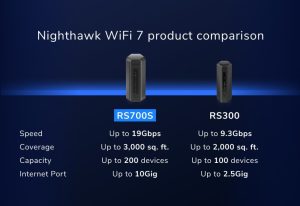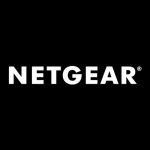IN THIS ARTICLE
The Evolution of WiFi Technology
WiFi was introduced for mass consumption in the late 1990s. Times have moved on from dual-band and tri-band WiFi to quad-band WiFi 7, and it’s more important than ever to have a top-tier WiFi router in today’s connected world. WiFi technology introduces internet users to a huge leap in home networking potential and performance. So, how did we get to this point?
The traditional IEEE WiFi naming protocols are clunky and confusing for the average user. To make WiFi standards easier to identify, a new naming system was introduced. For example, IEEE 802.11a is now also called WiFi 1, IEEE 802.11b is WiFi 2, etc. The latest WiFi 7 technology standard is the 7th generation, called IEEE 802.11be, or WiFi 7. Some of the earlier WiFi standards are now obsolete. Here is a brief timeline of the WiFi standards from the 90s to the present.
(WiFi 1) IEEE 802.11-1997 (802.11 legacy) – The original version of the standard IEEE 802.11 was released in 1997 and clarified in 1999. It is now obsolete.
(WiFi 2) IEEE 802.11b – 1999 – This standard uses the same modulation technique as the original standard. Devices using this standard experience interference from other devices in the 2.4 GHZ band.
(WiFi 3) IEEE 802.11g – 2003 – This standard works in the 2.4 GHz band (like 802.11b) but uses the same orthogonal frequency division multiple access (OFDMA) scheme as 802.11a. It has a maximum bit rate of 54 Mbps.
(WiFi 4) IEEE 802.11n – 2009 – A major WiFi improvement upon previous standards with the addition of multiple-input multiple-output antennas. 802.11n operates on both the 2.4 GHz and 5GHz bands and has data rate capability up to 600 Mbps.
(WiFi 5) IEEE 802.11ac – 2013 – Changes compared to 802.11n include wider 5GHz band channels (80 or 160 MHz versus 40 MHz), up to 8 spatial streams, higher-order modulation (up to 256 QAM), and the addition of Multi-User MIMO (MU-MIMO).
(WiFi 6/6E) IEEE 802.11ax – 2020 – This WiFi progression introduced the 6 GHz band alongside the 2.4 GHz and 5 GHz bands. It offers more efficient radio frequency usage and allows service providers to support emerging applications.
(WiFi 7) IEEE 802.11be – 2023 – Provides seamless wireless connectivity for fixed, portable, and moving stations within a local area. This latest standard delivers blazing-fast theoretical data rates as high as 42 Gbps, operating in the 2.4 GHz, 5 GHz, and 6 GHz frequency bands.
Advanced Features of WiFi 7 Routers
Today, wireless communication is superfast, offering multi-gigabit speeds for data-hungry devices. NETGEAR Nighthawk RS300 and RS700S WiFi 7 routers offer 360° antenna signal coverage and enhanced dedicated backhaul for dramatically improved network performance. WiFi 7 is the fast track for ultra-low latency streaming, podcasting, gaming, virtual reality, and smart home Internet of Things (IoT) applications. Wider coverage and stronger signal strength are crucial for modern UK homes, particularly those with large and unique architectural layouts. In addition, the number of remote workers in the UK is growing annually, and a powerful router is essential for uninterrupted connectivity.
NETGEAR Nighthawk and Orbi WiFi 7 utilise the additional bandwidth to create a dedicated WiFi backhaul channel. This reduces congestion and improves network reliability, making WiFi 7 routers ideal for use in dense urban environments. With Nighthawk and Orbi WiFi systems, the choices are yours for superfast wired or wireless backhaul between your router and devices. NETGEAR has a long-standing history and expertise in WiFi technology, showcasing how decades of pioneering innovation have culminated in their latest WiFi 7 routers.

Why the NETGEAR RS300 and RS700S are the Best
Nighthawk has the bases covered for standalone routers and mobile hotspots. Nighthawk RS300 and RS700S routers are ideal for medium-sized homes where multi-player gaming, HD streaming, and remote work are prioritised. NETGEAR routers, and mesh systems are perfect for families of all types, including renters and people who move often and don’t want to be tied down to a particular ISP. Nighthawk routers are among the top WiFi 7 routers and are ideal for homes with thicker walls that can be a challenge to WiFi signals. A powerful Nighthawk router could be the solution. NETGEAR Orbi Mesh is the alternative for WiFi coverage in large homes. Orbi whole-home mesh WiFi systems can deliver seamless connectivity from the front door to the garden.

NETGEAR Nighthawk RS300 Router
We’ve all been waiting for a budget-friendly WiFi 7 router with multi-gigabit speeds. NETGEAR Nighthawk RS300 is the best buy answer. The RS300 tri-band router retains all the important WiFi 7 advantages of its larger sibling, the RS700S router. Nighthawk RS300 offers WiFi speeds up to 9.3Gbps and coverage of up to 2,500 square feet for connecting up to 100 devices. RS300 features and specs include:
- Multi-gigabit Ethernet ports for dedicated devices requiring superfast speeds such as gaming consoles and AR/VR entertainment systems.
- Ability to create a smart home network that can include security systems, lighting systems, Amazon Alexa, smart TVs, and countless other WiFi-enabled applications and gadgets.
- Cloud storage backup/sync-up.
- File sharing using NAS with a multi-gig port or link aggregation.
- Easy file sharing by plugging a thumb drive into the router’s USB port.
- Compatibility with any internet service provider (ISP).
NETGEAR Nighthawk RS700S Router
This premium Nighthawk WiFi 7 router uses 320MHz bandwidth channels for faster speeds and superior quality of service. The RS700S quad-band router is considered one of the best high-speed routers on the market, offering ultra-low latency internet connections for real-time gaming and streaming. RS700S is ideal for families with uber-connected smart homes wanting to get the most from their multi-gig Internet service and need a lot of capacity for streaming, gaming, and entertainment devices. RS700S router features include:
- WiFi 7 speeds up to 19Gbps for real-time gaming, 4K/8K streaming, UHD video conferencing, and AR/VR entertainment.
- 2.4x faster speeds and significantly lower latency than WiFi 6 and WiFi 6E for optimal device performance.
- Sleek new router body with a smaller footprint and high-performance antennas for up to 3,000 sq. ft. of 360° WiFi Coverage.
- A 10 Gbps WAN internet port plus 10Gbps & 1Gbps Ethernet ports unlock unbeatable speed and reliability for wireless and wired connections.
- Automatic firmware updates and industry-leading safety features such as parental controls to help protect you and your family online.
- NETGEAR Armor with VPN provides an automatic security shield for your WiFi and connected devices against, spam, hackers, and other malicious intrusions. 1-year subscription included.
- Connect up to 200 devices simultaneously.
Real-World Reviews from UK Users
NETGEAR is a UK WiFi leader with a huge fanbase, for all the right reasons. An upgrade to NETGEAR Nighthawk will improve internet speeds, eliminate WiFi dead zones, and future-proof your home or office network. Here are a few real-world NETGEAR WiFi 7 router reviews from NETGEAR customers upgrading to RS300 and RS700S routers.
- “Love it so far. The Nighthawk RS300 WiFi router is very affordable and easy to install. Highly recommend upgrading your WiFi to this router.” – Troy Muilenburg.
- “Very pleased with the purchase. No issues at all with this top-notch router!” – Dawn Charles.
- “Extremely pleased with this router. Easy setup, Blazing speed, Awesome!!!!!!” – Dwight.
- “My old Nighthawk was 6 years old and was disconnecting often. I replaced it with the RS300 and have not had any issues. Connection is much better in rooms where it was weak before.” – anonymous.
Choosing the Best WiFi Router for Your Needs
NETGEAR Nighthawk WiFi 7 wireless routers and NETGEAR Orbi mesh router systems with multiple WiFi access points deliver new levels of responsiveness, lower latency, and faster speeds than ever. NETGEAR WiFi 7 bandwidth is expanded and optimised for faster throughput and backhaul, allowing you to connect seamlessly with broad 360° WiFi antenna coverage.
Consider your specific WiFi needs according to your home’s size, the number of connected devices and device users, and specific device usage patterns. Nighthawk routers include multi-gig LAN ports for Ethernet cable connections and are considered the best WiFi routers for Apple and Windows laptops, gamers, home cinema streaming, smartphones, and IoT devices. WiFi 7 is the latest WiFi standard introduced by the IEEE, offering blazing-fast multi-gigabit speeds on the 2.4GHz, 5GHz, and 6GHz channels.
If yours is an older router, it’s probably time for an upgrade. Next-generation NETGEAR Nighthawk RS300 and RS700S routers are state-of-the-art devices that will take you on a quantum leap into the future of wireless networking.


